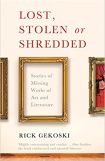Lost, Stolen or Shredded: Stories of missing works of art and literature by Rick Gekoski
| Lost, Stolen or Shredded: Stories of missing works of art and literature by Rick Gekoski | |
|
| |
| Category: Art | |
| Reviewer: John Van der Kiste | |
| Summary: Case histories of some of the greatest losses to culture, sometimes temporary and sometimes permanent, of great works of art and literature throughout the ages. | |
| Buy? Yes | Borrow? Yes |
| Pages: 284 | Date: April 2013 |
| Publisher: Profile | |
| External links: Author's website | |
| ISBN: 9781846674913 | |
|
| |
Over the centuries, many works of art have disappeared and then come back, or been returned almost as if they had never been away. Others, less fortunate, were simply destroyed. A very few never really existed at all. That is the basis of this unusual and very intriguing read from rare book dealer, writer and broadcaster Rick Gekoski.
In thirteen chapters he examines the case histories of different losses to our culture. As he does so, he asks what right we have over the continued existence of such artefacts. How much right do authors and artists have over what is their creation, and is it ever acceptable for them to be destroyed?
Throughout history many writers have consigned some of their manuscripts to the flames, or given orders to their friends, families or others for this to be done after their death. There is hardly anything shocking about this, as the author comments. Setting fire to a sheaf of handwritten pages or notebooks is no more than the equivalent of pressing the Delete button. Gerard Manley Hopkins deliberately threw some of his early poems on the fire, as did James Joyce a play and the first section of one of his novels, while Queen Victoria’s youngest daughter Princess Beatrice painstakingly copied out the more anodyne extracts from her mother’s journals and burnt the originals, to say nothing of some of Mama’s rather more contentious correspondence with some of her siblings. How many of us have started what we are sure is going to be a great literary masterpiece, and ended up dumping what briefly seemed like a good idea at the time on the bonfire?
All this is apparently acceptable. However Gekoski argues that the burning of two volumes of Lord Byron’s memoirs after his death in 1824 by friends and executors was a rather punitive over-reaction. The work had apparently been intended for publication, but his writings were consigned to the flames in order to protect the reputations of those who were presumably named in its pages. Byron, it is suggested, would have been remembered as a great memoirist as well as poet, had it not been for those who were determined to deny posterity a chance to make up their minds on the matter.
Closer to our own time was the matter of poet, librarian and jazz critic Philip Larkin asking his secretary and lover, three days before his death, to make sure his diaries did not long survive him. She obeyed his request punctiliously, putting them through the shredder and then incinerating the remaining strips of paper. In the words of his biographer Andrew Motion, these diaries were ‘sexual log-books, and a gigantic repository for bile, resentment, envy and misanthropy’. It was common knowledge during his lifetime that Larkin was not the happiest of men, and that some of his privately-expressed opinions probably made even Jeremy Clarkson look politically correct. Nevertheless Gekoski argues that perhaps the diaries could have been preserved, but not made available to the public for a long period – say, maybe seventy-five years. This is the case with much of the testimony given to police in the enquiry into the death by drowning of former Rolling Stone Brian Jones in 1969, as much of it centred on the private lives of those involved.
Some great paintings have also suffered various indignities, sometimes temporary, sometimes not. The opening chapter discusses the disappearance of Leonardo’s Mona Lisa from the walls of the Louvre in 1911. While the frame was found shortly afterwards in a stairwell, the canvas itself had gone. Suspicion was initially focused on a small band of radical artists such as the poet Apollinaire, who had recently called for all museums to be destroyed so the old could make way for the new, and even the youthful Picasso, who had signed a manifesto pledging to burn down the Louvre. Two years later the culprit, an Italian picture framer, returned the work and confessed all. We can once again enjoy the enigmatic smile of Leonardo’s sitter - but not the resigned, even grumpy stare of Sir Winston Churchill, who was painted by Graham Sutherland as Parliament’s eightieth birthday present in 1954. He hated the result so much that he and his wife had it destroyed within a couple of years, although the truth was not revealed until after his widow’s death in 1977.
These and several other incidents, from the theft of a mural from a gallery in New Zealand (reminding me of the case in 1974 when a charming Vermeer was stolen from Kenwood House, Hampstead, and thankfully recovered a few weeks later), and the sacking of the lost kingdom of Benin to the destruction of the library at Herculaneum, are discussed at length. Sometimes the author seems a little too ready to drift off-topic and reach the subject in hand by a curiously roundabout way. His chapter on the seizing of the Benin bronzes, for example, begins with some thoughts on the 1968 Olympic Games and the Black Power salute delivered by two bronze medal winners on the occasion. It is indeed relevant to an extent, but I felt he could have reached the actual subject of Benin a little more quickly than he did.
That slight caveat apart, this is an extremely interesting read on some of culture’s great survivors – and some of whose which did not survive. There are several illustrations in black and white throughout.
If this book appeals then you might also enjoy The Lost Mona Lisa by R A Scotti.
Please share on: ![]() Facebook,
Facebook, ![]() Twitter and
Twitter and
![]() Instagram
Instagram
![]() You can read more book reviews or buy Lost, Stolen or Shredded: Stories of missing works of art and literature by Rick Gekoski at Amazon.co.uk Amazon currently charges £2.99 for standard delivery for orders under £20, over which delivery is free.
You can read more book reviews or buy Lost, Stolen or Shredded: Stories of missing works of art and literature by Rick Gekoski at Amazon.co.uk Amazon currently charges £2.99 for standard delivery for orders under £20, over which delivery is free.
![]() You can read more book reviews or buy Lost, Stolen or Shredded: Stories of missing works of art and literature by Rick Gekoski at Amazon.com.
You can read more book reviews or buy Lost, Stolen or Shredded: Stories of missing works of art and literature by Rick Gekoski at Amazon.com.
Comments
Like to comment on this review?
Just send us an email and we'll put the best up on the site.


